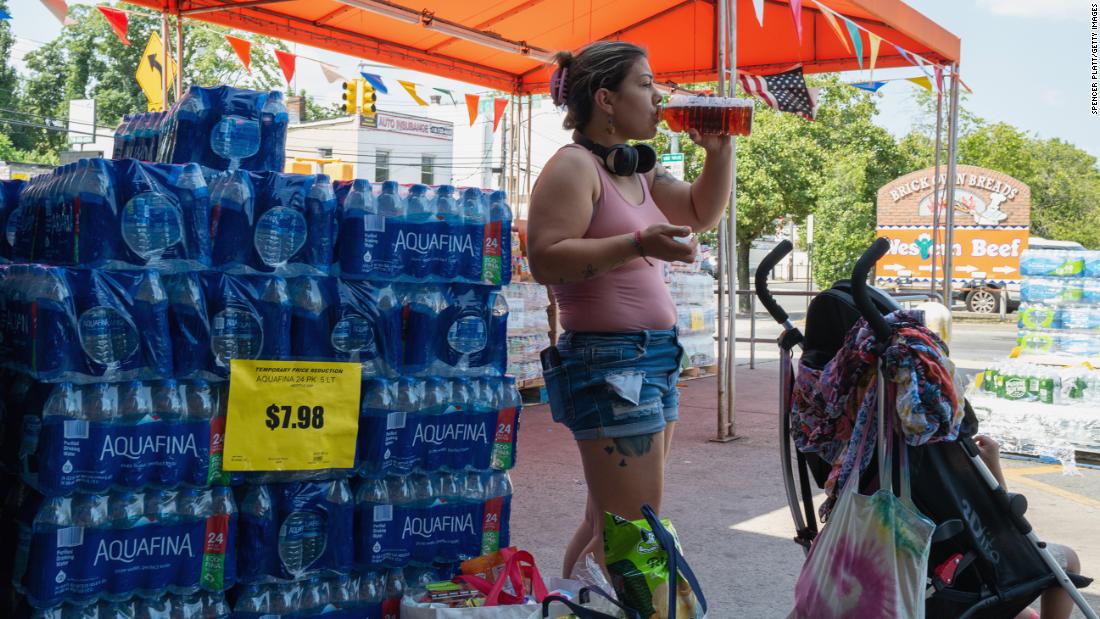That has led public officials to warn: Get to a cool place and check on each other.
Lawton, Oklahoma, tied its record high on Wednesday with thermometers reading 111 degrees. A daily high record was set in Abilene, Texas, which saw 110 degrees. Other parts of the state including Austin, Del Rio and San Antonio also broke daily records with temperatures soaring past 100.
But parts of the Ohio Valley and the Northeast — including New York City, Philadelphia and Boston — were also under heat alerts Wednesday and are expected to stay hot at least through the weekend.
Philadelphia declared a “heat caution” from noon Tuesday to Thursday evening, urging people to avoid being outside from noon to 5 p.m. and use air conditioners or fans, the city said in an email to CNN.
A heat health emergency is declared when “the temperature gets high enough that vulnerable people — especially our elderly neighbors and family members — are at an increased risk of getting sick or dying from the heat,” health commissioner Dr. Cheryl Bettigole said.
Record highs set Tuesday in Oklahoma and Texas
“We’re asking people to conserve power so that the systems continue to operate,” Austin Mayor Steve Adler said Wednesday. “We’re asking everybody to do that so that we can get through this together.”
The heat is giving air conditioning units a workout. The Electric Reliability Council of Texas, which operates about 90% of Texas’ power grid, set a one-day record for power demand Tuesday, and another record was expected Wednesday, an ERCOT spokesperson said.
The heat is helping cause water line breaks in some Oklahoma communities, which in turn is causing those communities to advise residents to boil their water. Because Oklahoma’s predominant soil type is clay, extreme temperatures constrict the soil, causing the ground to shift and pipes to break, according to the state Department of Environmental Quality’s water division.
Chief heat officers helping cities cope
Jane Gilbert, chief heat officer for Miami-Dade County, told CNN’s Don Lemon on Tuesday that Miami now has nearly double the days with a heat index — what the air feels like — over 90 degrees than it did in the 1970s.
“And we’re getting many, many more days with the heat index, the more extreme levels of 103, 105,” Gilbert said. “That is not only concerning to people’s health but their pocketbooks. Our outdoor workers can’t work as long, they lose work time. People can’t afford this AC, the higher electricity cost. It’s both a health and an economic crisis.”
“Elderly, young children, people with certain health conditions can be more vulnerable to the heat. It’s really important to check on those people and make sure that they have the ability to take care of themselves,” Gilbert said.
David Hondula, director of the Office of Heat Response and Mitigation for Phoenix, echoed that sentiment, saying, “The heat can affect everyone, we’re all at risk.”
Heat is one of the top weather-related causes of death in the US, according to Kimberly McMahon, public weather services program manager with the National Weather Service.
“Heat affects everyone by limiting the body’s ability to cool down,” McMahon said. And high humidity only further limits that ability.
“Sweating removes 22% of excess body heat by redirecting heat towards the evaporation of the sweat,” CNN meteorologist Robert Shackelford said. “High humidity means that there is more moisture in the air. Since there is significantly more moisture in the air, it causes sweat to evaporate slower, which leads to a slowing down of your body’s natural ability to cool. That is why heat indices on a day with high humidity can feel significantly hotter than the actual temperature of the air.”
Too much heat and humidity can lead to heat-related illnesses including heat cramps, a heat rash, heat exhaustion “and — the worst of all — heat stroke which can result in death,” McMahon said.
Correction: An earlier version of this story misstated the heat record in Lawton, Oklahoma. Temperatures on Wednesday tied Lawton’s previous record.
CNN’s Michelle Watson, Dave Hennen, Joe Sutton, Rebekah Riess, Paradise Afshar and Mike Saenz contributed to this report.
